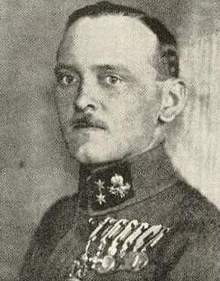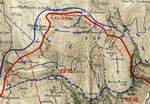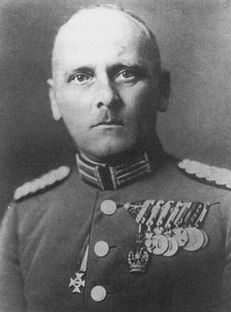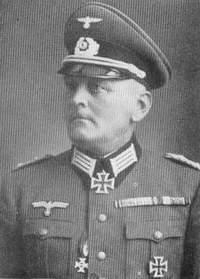Alois Windisch
 Alois
Windisch was born on the 3rd February 1892 at Fischau am Steinfeld in Lower
Austria. At the age of fifteen he entered the Maria Theresia Military Academy in
Wiener-Neustadt from which he graduated on the 18th August 1913 as a Leutnant
and was assigned as a platoon commander in the 9th Company of the Linz based
Infanterie-Regiment Nr.14. At the outbreak of the war he deployed to Galicia as
the Adjutant of the Regiment's First March Battalion and assumed command
of 9./IR.14 in late September. Wounded three times throughout the war, Windisch
remained with IR.14 for the entire duration of the conflict. Promoted to
Oberleutnant on the 1st May 1915 he had assumed command of the machine-gun
company of X./IR14 on the 15th January 1917 which was then serving on the
Italian front.
Alois
Windisch was born on the 3rd February 1892 at Fischau am Steinfeld in Lower
Austria. At the age of fifteen he entered the Maria Theresia Military Academy in
Wiener-Neustadt from which he graduated on the 18th August 1913 as a Leutnant
and was assigned as a platoon commander in the 9th Company of the Linz based
Infanterie-Regiment Nr.14. At the outbreak of the war he deployed to Galicia as
the Adjutant of the Regiment's First March Battalion and assumed command
of 9./IR.14 in late September. Wounded three times throughout the war, Windisch
remained with IR.14 for the entire duration of the conflict. Promoted to
Oberleutnant on the 1st May 1915 he had assumed command of the machine-gun
company of X./IR14 on the 15th January 1917 which was then serving on the
Italian front.
In November 1917 X./IR.14 was deployed in the area between
Primolano and Asiago in the Siebengemeinde or seven communities area under the command of
Feldmarschalleutnant Ernst von Kletter's Group. The group had taken up positions
North of the range of mountains - Mt. Castelgomberto-Mt. Tondarecar-Mt.
Badelecche with the battalion facing Mt. Castelgomberto. The general situation
and especially the oncoming winter weather necessitated the improvement of the
then prevailing untenable conditions through the removal of the protruding Mt.
Meletta massif to the South.
For this attack X./IR.14 was shifted to the area North of Mt.
Tondarecar and the assault was fixed for the 4th December. The operational objectives for the day were the taking of the line Mt.
Tondarecar (1668m)-Mt. Badelecche (1464m), the line of hills which with Mt.
Castelgomberto (1778m) and the massif
of Mt. Meletta (1824m) formed a half-circle which connected to form the
principal enemy defence in the area between Asiago and Brentatale. The rocky bastion like Northward protruding massif of
Mt. Castelgomberto was also be eliminated. Additionally the
enemy held positions on the Mt. Miela (1788m) massif between Mt. Tondarecar and
Mt. Meletta.
The operational objectives for the day were the taking of the line Mt.
Tondarecar (1668m)-Mt. Badelecche (1464m), the line of hills which with Mt.
Castelgomberto (1778m) and the massif
of Mt. Meletta (1824m) formed a half-circle which connected to form the
principal enemy defence in the area between Asiago and Brentatale. The rocky bastion like Northward protruding massif of
Mt. Castelgomberto was also be eliminated. Additionally the
enemy held positions on the Mt. Miela (1788m) massif between Mt. Tondarecar and
Mt. Meletta.
The assault by the battalion on Mt. Tondarecar on 4th December was
systematically executed. After the preparatory artillery fire and the blowing of
the enemy obstacles, the assault patrols penetrated into the enemy positions at
about 1020 hours. With supporting machine gun fire in support just behind, the
forward detachments rapidly crippled the resistance of the Italians on the peak
of Mt. Tondarecar and the sector was occupied according to instructions.
At this stage Oberleutnant Windisch realised that Mt. Miela in the
direction of attack was only lightly held as opposed to the strongly occupied
Northwest corner of Mt. Castelgomberto. He therefore received the approval of
the battalion commander to immediately take Mt. Miela with the machine gun
company and another company.
The assault group advanced up Mt. Miela in close touch with
patrols of the Southerly advancing Kaiserschützen-Regiment III  and
at a distance more friendly forces could be viewed advancing towards the
Southeast slope of the mountain. Windisch now had the knowledge that the
Kaiserschützen's attack on Mt. Badelecche had been successful. Windisch's assault group reached the peak of Mt. Miela without encountering any
enemy but received heavy enemy machine gun fire from their right flank on Mt.
Castelgomberto and fire from two guns South of that place. These however were
soon silenced by friendly machine gun fire. Despite a severe snowfall, Windisch thought he could discern
through the temporary break in the cloud cover
that the positions on Mt. Meletta were only weakly held and he immediately
decided to attack.
and
at a distance more friendly forces could be viewed advancing towards the
Southeast slope of the mountain. Windisch now had the knowledge that the
Kaiserschützen's attack on Mt. Badelecche had been successful. Windisch's assault group reached the peak of Mt. Miela without encountering any
enemy but received heavy enemy machine gun fire from their right flank on Mt.
Castelgomberto and fire from two guns South of that place. These however were
soon silenced by friendly machine gun fire. Despite a severe snowfall, Windisch thought he could discern
through the temporary break in the cloud cover
that the positions on Mt. Meletta were only weakly held and he immediately
decided to attack.
 Although he had been unable to secure the permission for this
venture from his battalion commander, he thought that in view of the success of
the Kaiserschützen to the South he would attempt to take Mt. Meletta. He
shifted his assault group to the Southern slope of Mt. Miela in order to be able
to provide some cover from the fire from Mt. Castelgomberto and moved off
towards the east under the fire support of the machine guns. His group advanced
through breaches in the enemy obstacles and surprised the enemy and by 1600
hours the entire enemy position on Mt. Meletta was in Austrian hands. Through
the elimination of this mountain and the system of trenches branching from it,
an Italian general had been killed and about 100 enemy officers and a further 3000
NCOs and men plus three guns were captured. During the attack, Windisch was
wounded in the ankle but remained with his group until success had been secured before
being evacuated to the dressing station.
Although he had been unable to secure the permission for this
venture from his battalion commander, he thought that in view of the success of
the Kaiserschützen to the South he would attempt to take Mt. Meletta. He
shifted his assault group to the Southern slope of Mt. Miela in order to be able
to provide some cover from the fire from Mt. Castelgomberto and moved off
towards the east under the fire support of the machine guns. His group advanced
through breaches in the enemy obstacles and surprised the enemy and by 1600
hours the entire enemy position on Mt. Meletta was in Austrian hands. Through
the elimination of this mountain and the system of trenches branching from it,
an Italian general had been killed and about 100 enemy officers and a further 3000
NCOs and men plus three guns were captured. During the attack, Windisch was
wounded in the ankle but remained with his group until success had been secured before
being evacuated to the dressing station.
 For
his success on 4th December 1917, Oberleutnant Windisch would be awarded the Knights'
Cross of the Military Order of Maria Theresa at the 192nd Promotion on the 11th
of December 1925. After recovering from his wound he
assumed command of the machine gun company in I./IR.14 until the war's end. He
remained in the new Austrian army - the Bundesheer and was promoted to Hauptmann
on the 1st of January 1921, Stabshauptmann on the 1st of June 1924, Major on the
19th of July 1928 (seniority from 20th of July) and Oberstleutnant on the 8th of
September 1932. By the time of the Anschluß he was a colonel (24th June 1936) and
an instructor in tactics on the senior officers'
course. Transferring into the Wehrmacht he was awarded the Knights' cross of the
Iron Cross on the 20th June 1940 for his command of Gebirgs-Jäger-Regiment 139
in Norway. Following further regimental and divisional commands he was captured
by the Americans in May 1945 having been promoted to major general on the 10th
of August
1943. Handed over to the Russians by the Americans in July 1945, he was further
extradited to Yugoslavia in May 1946 where he remained as a prisoner until the
30th of June1952.
For
his success on 4th December 1917, Oberleutnant Windisch would be awarded the Knights'
Cross of the Military Order of Maria Theresa at the 192nd Promotion on the 11th
of December 1925. After recovering from his wound he
assumed command of the machine gun company in I./IR.14 until the war's end. He
remained in the new Austrian army - the Bundesheer and was promoted to Hauptmann
on the 1st of January 1921, Stabshauptmann on the 1st of June 1924, Major on the
19th of July 1928 (seniority from 20th of July) and Oberstleutnant on the 8th of
September 1932. By the time of the Anschluß he was a colonel (24th June 1936) and
an instructor in tactics on the senior officers'
course. Transferring into the Wehrmacht he was awarded the Knights' cross of the
Iron Cross on the 20th June 1940 for his command of Gebirgs-Jäger-Regiment 139
in Norway. Following further regimental and divisional commands he was captured
by the Americans in May 1945 having been promoted to major general on the 10th
of August
1943. Handed over to the Russians by the Americans in July 1945, he was further
extradited to Yugoslavia in May 1946 where he remained as a prisoner until the
30th of June1952.
As well as being with Friedrich Franek the only holder of both of
the above mentioned Knights' Crosses, he held the Austrian Military Merit Cross
Third Class with War Decoration and Swords and both classes of the German Iron
Cross. Generalmajor Alois Windisch died at Wiener-Neustadt on the 28th December
1958.
Back to Miscellaneous
Biographies

 Alois
Windisch was born on the 3rd February 1892 at Fischau am Steinfeld in Lower
Austria. At the age of fifteen he entered the Maria Theresia Military Academy in
Wiener-Neustadt from which he graduated on the 18th August 1913 as a Leutnant
and was assigned as a platoon commander in the 9th Company of the Linz based
Infanterie-Regiment Nr.14. At the outbreak of the war he deployed to Galicia as
the Adjutant of the Regiment's First March Battalion and assumed command
of 9./IR.14 in late September. Wounded three times throughout the war, Windisch
remained with IR.14 for the entire duration of the conflict. Promoted to
Oberleutnant on the 1st May 1915 he had assumed command of the machine-gun
company of X./IR14 on the 15th January 1917 which was then serving on the
Italian front.
Alois
Windisch was born on the 3rd February 1892 at Fischau am Steinfeld in Lower
Austria. At the age of fifteen he entered the Maria Theresia Military Academy in
Wiener-Neustadt from which he graduated on the 18th August 1913 as a Leutnant
and was assigned as a platoon commander in the 9th Company of the Linz based
Infanterie-Regiment Nr.14. At the outbreak of the war he deployed to Galicia as
the Adjutant of the Regiment's First March Battalion and assumed command
of 9./IR.14 in late September. Wounded three times throughout the war, Windisch
remained with IR.14 for the entire duration of the conflict. Promoted to
Oberleutnant on the 1st May 1915 he had assumed command of the machine-gun
company of X./IR14 on the 15th January 1917 which was then serving on the
Italian front.  Although he had been unable to secure the permission for this
venture from his battalion commander, he thought that in view of the success of
the Kaiserschützen to the South he would attempt to take Mt. Meletta. He
shifted his assault group to the Southern slope of Mt. Miela in order to be able
to provide some cover from the fire from Mt. Castelgomberto and moved off
towards the east under the fire support of the machine guns. His group advanced
through breaches in the enemy obstacles and surprised the enemy and by 1600
hours the entire enemy position on Mt. Meletta was in Austrian hands. Through
the elimination of this mountain and the system of trenches branching from it,
an Italian general had been killed and about 100 enemy officers and a further 3000
NCOs and men plus three guns were captured. During the attack, Windisch was
wounded in the ankle but remained with his group until success had been secured before
being evacuated to the dressing station.
Although he had been unable to secure the permission for this
venture from his battalion commander, he thought that in view of the success of
the Kaiserschützen to the South he would attempt to take Mt. Meletta. He
shifted his assault group to the Southern slope of Mt. Miela in order to be able
to provide some cover from the fire from Mt. Castelgomberto and moved off
towards the east under the fire support of the machine guns. His group advanced
through breaches in the enemy obstacles and surprised the enemy and by 1600
hours the entire enemy position on Mt. Meletta was in Austrian hands. Through
the elimination of this mountain and the system of trenches branching from it,
an Italian general had been killed and about 100 enemy officers and a further 3000
NCOs and men plus three guns were captured. During the attack, Windisch was
wounded in the ankle but remained with his group until success had been secured before
being evacuated to the dressing station. For
his success on 4th December 1917, Oberleutnant Windisch would be awarded the Knights'
Cross of the Military Order of Maria Theresa at the 192nd Promotion on the 11th
of December 1925. After recovering from his wound he
assumed command of the machine gun company in I./IR.14 until the war's end. He
remained in the new Austrian army - the Bundesheer and was promoted to Hauptmann
on the 1st of January 1921, Stabshauptmann on the 1st of June 1924, Major on the
19th of July 1928 (seniority from 20th of July) and Oberstleutnant on the 8th of
September 1932. By the time of the Anschluß he was a colonel (24th June 1936) and
an instructor in tactics on the senior officers'
course. Transferring into the Wehrmacht he was awarded the Knights' cross of the
Iron Cross on the 20th June 1940 for his command of Gebirgs-Jäger-Regiment 139
in Norway. Following further regimental and divisional commands he was captured
by the Americans in May 1945 having been promoted to major general on the 10th
of August
1943. Handed over to the Russians by the Americans in July 1945, he was further
extradited to Yugoslavia in May 1946 where he remained as a prisoner until the
30th of June1952.
For
his success on 4th December 1917, Oberleutnant Windisch would be awarded the Knights'
Cross of the Military Order of Maria Theresa at the 192nd Promotion on the 11th
of December 1925. After recovering from his wound he
assumed command of the machine gun company in I./IR.14 until the war's end. He
remained in the new Austrian army - the Bundesheer and was promoted to Hauptmann
on the 1st of January 1921, Stabshauptmann on the 1st of June 1924, Major on the
19th of July 1928 (seniority from 20th of July) and Oberstleutnant on the 8th of
September 1932. By the time of the Anschluß he was a colonel (24th June 1936) and
an instructor in tactics on the senior officers'
course. Transferring into the Wehrmacht he was awarded the Knights' cross of the
Iron Cross on the 20th June 1940 for his command of Gebirgs-Jäger-Regiment 139
in Norway. Following further regimental and divisional commands he was captured
by the Americans in May 1945 having been promoted to major general on the 10th
of August
1943. Handed over to the Russians by the Americans in July 1945, he was further
extradited to Yugoslavia in May 1946 where he remained as a prisoner until the
30th of June1952.